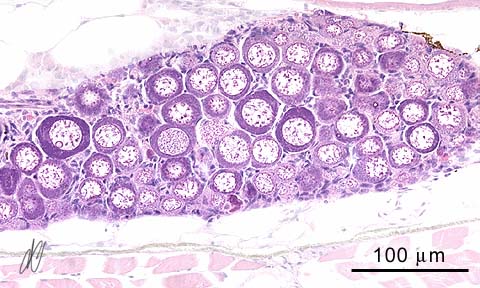The Zebrafish in Toxicology/Ovary staging
Jump to navigation
Jump to search
- an interactive version of this book is available here
- back to Table of Contents - The Zebrafish in Toxicology
Reproduction - Ovary
[edit | edit source]Normal Histology
[edit | edit source]ovary development
[edit | edit source]previtellogenic stageing: sequential images
previtellogenic stageing: sequential images
Six subsequent previtellogenic (intermediate) stages of ovary maturation, as recorded in juvenile zebrafish 6 weeks of age, and classified according to the most predominant oocyte maturation stage.
For structure analysis of these images, see structure – immature.
An example of the application of this classification is the evaluation of the effects of effluent of a sewage treatment works (Eindhoven, the Netherlands) in zebrafish, shown at the bottom of this page.






